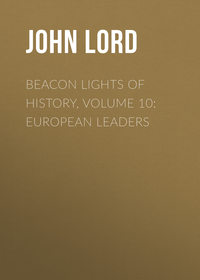 полная версия
полная версияBeacon Lights of History, Volume 14: The New Era
But the century was not out of its second decade when signs of an awakening from this lethargy began to show themselves. The first steps, naturally, were along preparatory lines, and for those we are largely indebted to the physicists, the chemists, and the botanists. Gross anatomy became better known, owing for the most part to more enlightened legislation on the subject of the dissection of the human body; minute anatomy (histology) sprang into existence as the result of improvements of the compound microscope. Physiology took on something of the experimental; and medication was rendered far less gross and repulsive by the isolation of the active principles of medicinal plants. But it was long after all this that the telling strides were taken. Up to within the memory of many men who are now living, "peritonitis" tortured its victims to death, said "peritonitis" being often interpreted as a manifestation of rheumatism, for example, and no well-directed interposition was attempted against it, whereas we now know perfectly well that the vast majority of cases of peritonitis are due to local septic poisoning and for the most part quite readily remediable by the removal (with a minimum of danger) of the organ from which such poisoning arises–almost always the vermiform appendix. "Appendicitis," of which we hear so much nowadays, is no new disease; it is simply the "peritonitis" that killed so many people in former times. But while no well-informed person would now maintain that this disease was a new one, there are many, and those, too, among the best instructed, who find it difficult to avoid the conclusion that, if not new, it must at least be of far more frequent occurrence than formerly. It must be borne in mind, however, that in the great majority of instances in past years it ended spontaneously in recovery and was forgotten.
Two features of the progress in medicine in the Nineteenth Century, negative as they may seem to have been, were undoubtedly potent in the promotion of advance. They were the recognition of the fact that many dangerous diseases are self-limited, and the experiment of the so-called "expectant treatment." The result of the first of them was to teach men to desist from futile attempts to cure the self-limited diseases, in the sense of cutting them short in their course, and the "expectant treatment" followed as a natural consequence. It was a method of managing disease rather than attempting to cure it. There was no interference save to promote the patient's comfort, to nourish him as thoroughly as might be without unduly taxing his powers, and to meet complications as they arose. It was stooping to conquer, perhaps, but it was a policy that conduced greatly to the well-being of the sick, improved their chances of recovery, and enabled physicians to study disease more accurately by reason of its course not being rendered irregular by meddlesome medication. It has never been dropped, and it never will be, save as such directly curative agents as the antitoxines are made available.
In the early part of the century, except for gross anatomy and operative surgery, medicine was taught almost wholly, so far as the schools were concerned, by means of didactic lectures. The "drawing" capacity of a professor was proportionate rather to his rhetorical powers and to the persuasiveness with which he inculcated the views peculiar to himself than to the amount of real information that he conveyed to the students. Although the apprentice system–for that was what the practice of students' attaching themselves to individual practitioners, whom they called their preceptors, virtually amounted to–in many instances made up more or less completely for the lack of systematic clinical teaching, yet in the great majority of cases it amounted to little more than the preceptor's allowing the student the use of his library and occasionally examining into the latter's diligence and intelligence, in return for which he, the preceptor, required an annual fee and exacted from the student such minor services as his proficiency enabled him to render. It is true the students "walked" the hospitals, drinking in some great man's utterances, but they did it in droves, not a moiety of them being able to get a good look at a patient, unless it was such a passing glance as might tell them that the patient was jaundiced. By clinical teaching we understand teaching, not in glittering generalities, but in the concrete, either at the bedside, as the word clinical originally implied, or at least with the patient actually present to illustrate in his person the professor's descriptions and the success or failure of the treatment employed. The clinic is now firmly established, and has been for years, but it was long before this grand result was attained.
Experimental methods of study gradually came into vogue, particularly in the domain of physiology. In this sphere Dr. William Beaumont, of the United States Army, was a pioneer. His historic experiments on Alexis St. Martin, a soldier who had been wounded in the stomach and recovered with a permanent opening into that organ, will ever rank among the most important of the early experimental studies of digestion. It was not long before Claude Bernard extended similar inquiries to the other functions of the body, notably those of the nervous system; and since his time there has been a long array of brilliant investigators of physiology and of other branches of science tributary to medicine. Experiments on living animals were almost the only means of carrying on these researches. In the early days the animals employed were doubtless put to a great deal of pain–perhaps in many instances to unnecessary suffering–and an altogether laudable feeling of humanity has led good people to band themselves together for the purpose of putting a stop to vivisection, or at least of greatly restricting the practice and of freeing it from all avoidable infliction of pain. These praiseworthy efforts have in some instances been carried so far, unfortunately, as to seriously hamper scientific investigation–investigation which has for its object the alleviation of human suffering and the saving of human life. We may earnestly deprecate and strive to prevent wanton reiteration of painful experiments for purposes of demonstrating anew that which is unquestioned, and we may resort to all possible means to render necessary experiments free from actual pain (from the anguish of trepidation we can seldom relieve the poor animals), but let us not block the wheels of scientific progress.
At the dawn of the Nineteenth Century, to examine a sick person's pulse, to inspect his tongue, to observe his breathing, to interrogate his skin by our sense of touch, and to try to make his statements and those of his friends fit in with some tenable theory of the nature of his ailment, were about all we could do. Possibly it was because he realized to an uncommon degree the tremendous impediment of this narrow limitation that Samuel Hahnemann, the founder of Homoeopathy, cut the Gordian knot in sheer rebelliousness, and proclaimed, as he virtually did, that a diagnosis was not necessary to the successful treatment of disease, but that one only needed to know empirically how to subdue symptoms, meaning mainly, if not solely, what we term "subjective" symptoms–those of which the patient complains, as opposed to those that we ourselves discover. But the physical examination of the sick, before extremely meagre in its sphere and restricted in its possibilities, was destined to expand before many years into the minute and positive physical diagnosis of the present day.
In the year 1816 a French physician, Réné Théophile Hyacinthe Laennec, achieved undying fame by publishing to the world an account of his labors in the application of mediate auscultation and of percussion to the diagnosis of the diseases of the chest. It is true that no less a personage than the "Father of Medicine," Hippocrates, is reputed to have practised succussion as a means of diagnosis; that is, the shaking of a patient, as one would shake a cask, to ascertain by the occurrence or non-occurrence of a splashing sound if the person's pleural cavity was distended partly with water and partly with air. It is probable that Hippocrates and many others after him carried the physical examination of the chest still further, for it is difficult to imagine, for example, that so simple a device as that of thumping a partition to make out the situation of a joist by the sound evoked should not early have been applied to the human chest. But, be this as it may, to Laennec belongs the great credit of having laid a substantial foundation for the physical diagnosis of the present time, and, more than for laying a foundation, for constructing a fairly complete edifice. He who should now undertake to practise general medicine without having first made himself proficient in the detection and interpretation of the sounds elicited by auscultation and percussion in diseases of the heart and lungs would foredoom himself to failure.
It was not until many years later, early in the second half of the century, that the clinical thermometer came into general use, but it soon showed most strikingly the superiority of the "instrument of precision" to the unaided senses of man. Who would think now of trying to estimate the height of a fever by laying his hand on the patient's skin, or who, even among the laity, would be satisfied with such a procedure? "Doubtless," said the present writer in a former publication ("New York Medical Journal," Dec. 29, 1900), "the use of the thermometer has occasionally given rise to needless alarm, but almost invariably it may be interpreted with great certainty. Often it dispels unnecessary anxiety as in a twinkling by its negative indication, and surely it is to be credited with being distinctly diagnostic in those diseases of which it has itself established the 'curve.'" By the thermometric "curve" of a disease is understood the general visual impression made by the graphic chart of a temperature record–the course of a zigzag line connecting the points indicated by the various individual observations.
Numerous other instruments of precision are now in constant use, among the most wonderful of which perhaps is the ophthalmoscope, whereby we are enabled to subject the retina and the intervening media of the eye to minute visual examination. There is not an organ of the body that is not now interrogated daily in the way of physical diagnosis, and we even examine separately the secretion of each of the two kidneys. In addition, there are multitudinous specific signs of which we were not long ago in complete ignorance. To cite only one of these, there is Widal's agglutination test, by which the bacteriologist can usually make a diagnosis of typhoid fever far in advance of the time at which it could otherwise be distinguished. The use of the Röntgen rays in diagnosis was one of the crowning achievements of the century, and now we seem about to enter upon a course of their successful employment in the treatment of disease–even some forms of cancer–as well as in its detection.
Beyond the vermin that infest the skin and the hair, tapeworm, and a few other intestinal worms, little if anything was known of morbific parasites before the Nineteenth Century; but the labors of Van Beneden, Küchenmeister, Cobbold, Manson, Laveran, and others have now established the causal relationship between great numbers of animal parasites–gross and microscopic–and certain definite morbid states. This has led to a great increase in our knowledge of the connection between the parasites of the lower animals and grave disease in human beings, and on this knowledge rest many of the precautions that we are now able to take against the spread of such disease. From the consideration of animal parasites as the direct causes of disease, we naturally come to the contemplation of the subject of insects as the carriers of disease. The later years of the century have witnessed the demonstration of the fly's agency in the transmission of malignant pustule and typhoid fever, and that of certain mosquitoes in the conveyance of yellow fever and malarial disease. We now know that bad air (the original meaning of the word malaria) has nothing to do with fever and ague, and that swamps are not unwholesome if they are free from infected mosquitoes. The mosquito does not originate the malarial infection; it simply serves as the temporary host of the micro-organism (Plasmodium malarioe) which is the cause of the disease, having obtained its transient "guest" from some human being. Consequently, marshy districts that are full of mosquitoes are not malarious unless the mosquitoes are of the kinds capable of lodging the plasmodium, and unless there is or has recently been present in the neighborhood some person affected with malarial disease. Moreover, the most virulently malarious region is a safe place of residence for human beings, provided they protect themselves absolutely against the bite of the mosquito. This has been strikingly demonstrated in the case of the Roman Campagna.
From the disease-producing animal parasites we come now to those that are believed to be of vegetable nature. Under the general name of bacteria, there are multitudes of micro-organisms having pathogenic powers, each giving rise to some definite specific disease, and certain associations of different bacteria causing particular morbid conditions. Generations ago physicians had a glimmering of what we now term the germ theory of disease, as was shown by their use of such expressions as materies morbi and morbid poisons. Even the definite relationship of special microscopic organisms to individual diseases was foreshadowed by Salisbury nearly fifty years ago. But it was not until years after those conceptions, and in no wise descended from or led up to by them, that an intelligible and satisfactory germ theory of disease was formulated.
It is to Pasteur, the immortal chemist, that we owe this theory, as well as that of the attenuation of viruses–both of more than theoretical import, since they have given us aseptic surgery, the power of frequently preventing hydrophobia, the antitoxine treatment of diphtheria, and the ability to stay the hand of Death in the form of many a stalking pestilence. Every infectious disease is now held to be due to its own particular micro-organism, and many diseases that were not until recently thought to be infectious are now classed as such because they have been proved to be caused by living germs. Conspicuous among these diseases is pulmonary consumption. In the case of almost every one of these diseases we have discovered the specific germ and are able to demonstrate its presence, either by its microscopical appearance, by its behavior on contact with certain stains, or by the forms that cultures of it assume. The micro-organism of small-pox and that of cancer (the existence of which is assumed) have not yet been isolated. Some of these germs, like that of tetanus (lockjaw), gain entrance to the system only through a wound; others, like those of typhoid fever and cholera, are swallowed; others, like that of pneumonia, are inhaled; still others, like that of tuberculous disease, are either swallowed or inhaled. Some are believed to be transmissible to the unborn child; and a few are ordinarily harmless parasites, becoming pathogenic only when they accidentally gain access to other parts of the system than those which constitute their natural habitat.
These microscopic organisms do not by their mere presence set up disease, unless indeed they are in such overwhelming numbers as to block the capillary blood vessels mechanically. Some of them are carried broadcast in the blood current, while others remain at the point of entrance; in either case they elaborate certain products, termed toxines, which act, either locally or through the circulation, to cause the disease. These toxines eventually kill the micro-organisms that produced them, quite as an animal may be smothered in its own exhalations; or at least they would do so if the "host" survived long enough for the completion of the process. Meantime, they have either killed the "host" or been defeated by certain very interesting natural processes. But before either of these occurrences has had time to take place, fortunately, in the great majority of instances, save those of exposure to the most deadly of infections, the vital power of the invaded individual has coped successfully with the invaders at the very point of attack–has repulsed the attacking party without appreciable impairment of its own force–and no illness results. For example, practically all of us inhale the germ of consumption repeatedly, but most of us suffer no harm from it simply because the fluids which bathe the surface on which the germ effects a lodgment are endowed with properties which either kill the germ or rob it of its power for harm; but these properties suffice only when the general health is unimpaired.
In case the attack is not successfully repelled at the outset, what happens? There begins a struggle between the invaders and what may be called the reserves of the organism, consisting of the white blood corpuscles, which undergo a great augmentation in number. These corpuscles are endowed with the faculty of amoeboid movement; that is to say, they may shoot out projections from their substance, and even convert themselves for the time being into traps, seizing upon the pathogenic bacteria, incarcerating them within their own mass, and carrying them away to be thrust out of the system by organs whose function it is to eliminate extraneous matter. These corpuscles are, indeed, said figuratively to eat the malign micro-organisms, whence they have been termed phagocytes (from [Greek: phagein], to eat, and [Greek: kutos], a cell); also because they carry away refuse and noxious material, they have been called "the scavengers of the system." By means of their amoeboid movement they are enabled to worm themselves through inconceivably minute apertures in the blood vessels, and attack and devour peccant matter wherever it may have effected a lodgment. These white corpuscles are also known as leucocytes, and their increase in number when they are called upon to resist bacterial invasion is spoken of as hyperleucocytosis. The discovery of their protective function is to be credited to Metchnikoff, a Russian physician now teaching in Paris. When they migrate from the blood vessels in great numbers they finally, after having fulfilled their office as phagocytes, degenerate into the corpuscular elements of pus, which is the creamy liquid contained in an abscess. Their migratory power was discovered by Cohnheim.
But as a general thing the phagocytes do not succeed in making away with all the pathogenic germs, or even with enough of them to prevent the illness which they tend to produce. The further combat is between the poisonous products, termed toxines, engendered by the bacteria and certain antidotal substances, called antitoxines, newly created in the watery portion of the blood by some wonderful provision of Nature that is not yet well understood. Each infective disease has its special toxine, and for the destruction of each the blood prepares its particular antitoxine; possibly, however, some of the antitoxines may be efficacious against more than one kind of toxine, for there are physicians who are convinced that vaccination is a temporary preventive of whooping-cough. But the elaboration of an antitoxine takes time, and the result in any given case, whether in recovery or in death, seems to be settled by the ability or inability of the vital powers of the individual to hold out until they are relieved by the evolution of the necessary amount of antitoxine.
In the long run, provided the sick person survives, more antitoxine is generated than is required to save life. The excess remains in the system for a greater or lesser length of time, and this fact explains the individual's subsequent immunity to the disease from which he has recovered; any fresh invading force of the microbes of that disease finds that defensive preparations have been made in advance. In the case of some diseases this acquired immunity is usually lifelong, as in that of small-pox; in others, of which influenza is a notable example, it is as a rule very transitory; and there are all gradations between the two. It is thought that this acquired immunity to some diseases may be transmitted to the offspring, for it is quite certain that there are many people who are from birth insusceptible to scarlet fever, no matter what may be the extent of their exposure to that disease.
The recognition of Nature's elaboration of protective antitoxines has led to their artificial cultivation in the lower animals, and, thus produced, they have been used with brilliant results in the prevention and cure of at least one formidable disease, diphtheria. The immense reduction of the mortality from this disease that has followed the introduction of the treatment with the artificial antitoxine we owe to Behring, of Germany, and Roux, of France. Omitting unnecessary details, we may describe the process of obtaining diphtheria antitoxine as follows: A certain amount of diphtheritic poison (of the bacteriological sort, prepared by cultivating the diphtheria microbe) is injected into the circulation of a horse–sufficient to make the horse sick, but not enough to endanger his life. The horse's system straightway begins to elaborate the protective antitoxine, and there results from this one injection a sufficient amount of it to save the horse, although far too little to make the serum of his blood potent enough for medicinal use. Hence, after the lapse of a suitable interval, he is again injected with diphtheritic poison, and for the second time his blood begins to generate the antitoxine. And the process is repeated again and again, the virulence of the poison being increased each time, until the horse's blood is fairly reeking with antitoxine. Then blood is drawn freely from the horse, and it is allowed to separate into clot and serum, the latter alone being the part destined for use. This serum is tested on a small animal that has been inoculated with a deadly dose of the diphtheritic poison; if it saves the little creature from death, it is assumed to be potent enough for use on human beings, and, handled with all possible precautions against putrefaction or any contamination with pathogenic bacteria, it is furnished to physicians, its degree of potency being designated in "units."
If in this brief article, which does not purport to be more than a sketch of the tremendous strides made by medicine in the Nineteenth Century, so much space has been given to the germ theory of disease, it is because the demonstration of the truth of that theory has been absolute, and has constituted the very marrow of almost all the medical progress of the century that has been the outcome of continuous thought and study as opposed to chance discovery.
Such results as the germ theory has now led to in the treatment of diphtheria it had already accomplished in the field of surgery as a consequence of that strict asepticism which, originating with Joseph Lister (now Lord Lister), and rapidly carried by him to a condition verging on technical completeness, was soon taken up by surgeons all over the world and brought wellnigh to perfection, so that the mortality of wounds of all sorts has been tremendously reduced, and many surgical operations are now practised frequently–indeed, whenever the occasion for them arises–that before the days of Listerism would have been looked upon as almost tantamount to the patient's death-warrant. More particularly is this the case as to operations which involve opening into the abdomen, the chest, or the cranium. So little risk now attaches to such operations, properly performed, that the opening of the abdominal cavity for the mere purpose of ascertaining the condition of its contents–"exploratory laparotomy," as it is called–is a matter of constant occurrence. Curiously enough, in some way not yet satisfactorily explained, that procedure in itself, without anything further being done, has in many instances resulted in decided amelioration of a morbid condition, if not in its cure. A striking example of this is seen in the benefit that often results in cases of one form of "consumption of the bowels," namely, tuberculous disease of the membrane that lines the abdominal wall and invests the abdominal organs. This is not the only operation that does good mysteriously; that of cutting out a bit of the iris in a form of deep-seated eye disease, glaucoma, that tends toward complete blindness, is hardly more explicable; neither is an incision of the capsule of the kidney for certain forms of Bright's disease, each of which stays the progress of the trouble in a goodly proportion of instances.









